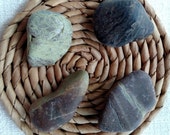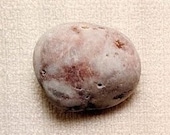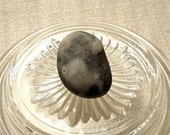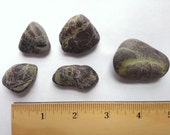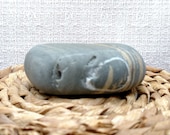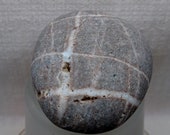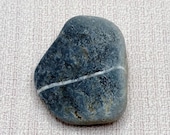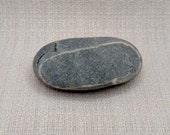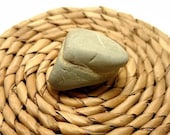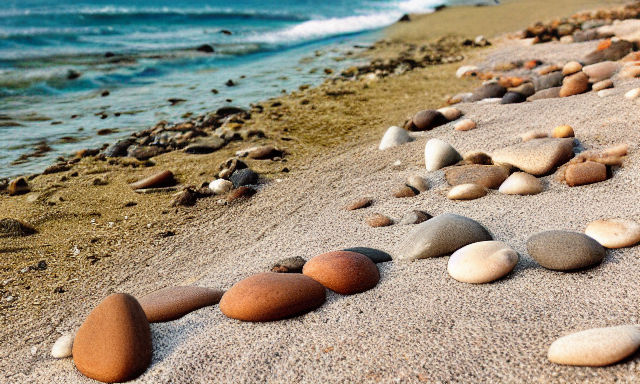Mica Schist Stones – The Coastal Wonders
Formation of Mica Schist Rock: The Geological Ballet
Mica Schist takes its captivating form through a geological dance that unfolds over millennia. Originating as a protolith, a precursor rock, the metamorphic journey of Mica Schist begins in the depths of the Earth. Subjected to intense heat and pressure, this protolith experiences a profound transformation, evolving into the enchanting stones that grace the Northeastern shores.

Picture the Earth’s deep interior as a stage where minerals perform a ballet, each movement dictated by the forces shaping their destiny. Mica Schist’s tale involves a delicate choreography of minerals like mica, quartz, and feldspar, each playing a unique role. The heat and pressure act as the music, orchestrating the dance of mineral crystals into a symphony of geological artistry. Understanding this process allows us to appreciate not just the beauty but the intricate science that sculpts Mica Schist.
Texture and Composition: The Unique Identity
As we run our fingers over Mica Schist, its texture becomes a tactile storybook, narrating its metamorphic heritage. The hallmark of this rock lies in the arrangement and size of its mineral grains, shaped during its transformative journey. Mica, with its distinctive platy structure, adds a unique character, giving the rock a sheen that catches the light.
Digging deeper into its identity, the mineral composition of Mica Schist becomes a fascinating exploration. Mica, the star player, interacts with other minerals like quartz and feldspar to compose a rock that is both visually captivating and structurally robust. It’s in this intricate interplay of minerals that Mica Schist forges its unique identity, setting it apart in the geological gallery.
Geological Significance: Abundance on Coastal Fronts
Why does Mica Schist choose the Northeastern coast as its preferred stage? Comparative studies, especially with its geological sibling granite, illuminate the reasons behind its coastal prevalence. The geological forces at play, including ancient tectonic movements and metamorphic events, shape the bedrock of this region, birthing an abundance of Mica Schist.
Imagine the geological narrative written in the rocks beneath the coastal soil. Forces deep within the Earth’s crust set the stage, uplifting and exposing the metamorphic marvels that we now find scattered along the shores. Understanding the geological significance involves decoding this narrative, appreciating the forces that have shaped the coastal landscape and made Mica Schist a geological star of the Northeast.
Coastal Beach Stones
Properties of Mica Schist: Unveiling Durability and Beauty
In the hands of nature’s sculptor, Mica Schist reveals its intrinsic properties, adding depth to its geological tale. Hardness and color, two key aspects, intertwine to narrate the durability and visual allure that make Mica Schist a highly sought-after rock type.
Hardness and Color: Nature’s Signature
Hardness becomes the silent testament to Mica Schist’s resilience. The mineral arrangement within the rock dictates its resistance to abrasion and wear. Exploring this property unveils not just the physical robustness but the enduring spirit encapsulated in each Mica Schist stone.
Color, on the other hand, is the palette that nature employs to paint these geological masterpieces. From the subtle hues of grays and greens to the glistening reflections of mica, the color spectrum of Mica Schist is a testament to the intricate dance of minerals during its formation. Together, hardness and color form the signature of nature’s artistry etched into every Mica Schist specimen.
Utilizing Mica Schist Stones: Beyond the Shoreline
While Mica Schist finds its origin on the Northeastern shores, its journey extends far beyond the rhythmic lapping of waves. Transitioning from a coastal beauty to a versatile resource, these stones contribute significantly to human activities, showcasing their myriad uses.
Multifaceted Uses: From Construction to Art
Can Mica Schist be more than a mere aesthetic marvel? The answer unfolds as we explore its multifaceted applications. Beyond gracing the coastline, Mica Schist finds purpose in construction, becoming a robust building material. Its presence extends into the realm of art and decoration, where its unique texture and color add a distinctive touch to creative endeavors.
From sturdy foundations to expressive sculptures, Mica Schist transcends its geological origins, becoming a versatile player in the arenas of construction and artistic expression. Understanding these diverse roles enhances our appreciation for the myriad ways in which these unique stones become integral to human activities.
Wishing Rocks
Conservation and Discovery: Preserving Geological Legacy
Guidance on the proper storage and conservation of Mica Schist Stones is a crucial aspect of preserving their geological legacy. These stones, forged through intricate processes spanning millennia, deserve careful attention to maintain their integrity.
Identifying Regions and Popular Beachcombing Spots
Beyond conservation, knowing where to find Mica Schist is a treasure map for enthusiasts. Commonly gracing specific beachcombing spots along the Northeastern coast, these stones invite exploration. Understanding these regions not only aids in discovering these geological wonders but also contributes to the broader narrative of the Earth’s geological history, etched in the rocks along the shorelines.
Assessing Value: What Makes Mica Schist Beach Stones Precious
Deciphering the value of Mica Schist Beach Stones unveils a captivating tale of geological intricacies and aesthetic allure. For collectors and geology enthusiasts, understanding the factors that contribute to the value of these stones transforms them from beach treasures to precious geological gems.
Geological Tapestry: A Story in Every Stone
Each Mica Schist Beach Stone is a storyteller, weaving tales of its metamorphic journey, the geological forces that shaped it, and the unique mineral composition that gives it character. Collectors keen on assessing the value of these stones delve into the intricate tapestry of their geological narrative, recognizing the subtle nuances that make each specimen distinct.
Artistic and Scientific Applications: Creative and Analytical Dimensions
Beyond the realms of geological marvels, Mica Schist Stones emerge as artistic and scientific treasures. The creative applications of these stones in art are a testament to their unique texture and color. Artists carve, shape, and polish Mica Schist, turning it into expressive sculptures that capture the essence of Earth’s transformative processes.
On the scientific front, Mica Schist Stones become valuable subjects of study. Their mineral composition, properties, and transformational journey offer insights into geological processes, contributing to the broader understanding of Earth’s history. Mica Schist, once a coastal beauty, transcends its rocky origin to become a canvas for both artistic expression and scientific exploration.
Unearthing the Past and Debunking Myths: Tracing Origins
Embarking on a historical journey through time, we trace the origins of Mica Schist. Investigating its protolith and crystal size unveils the geological events that shaped these stones over millennia. Myths surrounding Mica Schist, such as its supposed relationship with salt and buoyancy, are debunked, revealing the scientific truths behind these fascinating coastal treasures.
Exploration and Appreciation: Northeastern Coastal Beauty
For enthusiasts and collectors, the Northeastern coast unveils a treasure trove of Mica Schist Beach Stones. This detailed guide provides insights into where to find these geological wonders, turning beachcombing into a thrilling adventure. Exploring the Northeastern coastal beauty, appreciating the unique features of Mica Schist, and discovering where to acquire these stones for personal collections contribute to the charm of this coastal exploration.
The journey through the world of Mica Schist Stones takes us from their geological formation to their artistic and scientific significance. Exploring their uses, properties, and conservation adds depth to the appreciation of these stones, inviting readers to embrace the enchanting beaches of the Northeast in search of these natural wonders.
Balancing Rocks – Cairns
Seeking the Glittering Secrets of Mica Schist on Northeast Beaches
Embracing the Coastal Quest
Picture yourself strolling along the Northeastern shores, where the rhythm of the waves serenades the coastline. Amidst the seashells and pebbles lies a hidden gem – Mica Schist Beach Stones. These aren’t just rocks; they are fragments of geological stories waiting to be discovered.
The Beachcomber’s Delight
For the avid beachcomber, these shores are a treasure trove. Patiently scanning the tideline, you might spot Mica Schist Stones winking back at you, their mica flecks catching the sunlight like nature’s own glitter. They often stand out with a unique blend of sheen and texture, making them distinct in the mosaic of coastal finds.
The Art of the Hunt
Finding Mica Schist Stones is an art, a patient pursuit that connects you to the Earth’s transformative forces. During low tide, explore the exposed areas where the waves have sculpted the coastline. These stones might be nestled among their peers, waiting for your keen eye to claim them.
Where to Begin
Start your quest at renowned beachcombing spots along the Northeastern coast. From the rocky coves of Maine to the sandy stretches of Cape Cod, each location offers a canvas for Mica Schist discovery. Keep an eye out during your seaside strolls, especially after storms when the ocean might generously unveil new treasures.
The Joy of Discovery
As you uncover these glimmering stones, each one becomes a token of your coastal adventure. Share the joy – whether you’re a seasoned collector or a first-time explorer, finding Mica Schist Beach Stones is about more than the rocks themselves; it’s about the stories they carry and the connection they forge between you and the ancient forces that shaped them. So, go ahead, let the Northeastern beaches be your guide to the captivating world of Mica Schist. Happy hunting!
Mica Schist FAQ
What Type of Rock is Mica Schist?
Mica Schist is a metamorphic rock characterized by the presence of mica minerals, giving it a distinctive sparkle. Formed through intense heat and pressure, it tells a geological tale of transformation.
What is Mica Schist Used For?
The applications of Mica Schist are diverse. While it’s not a primary choice for construction, its unique texture and appearance make it a sought-after material for ornamental purposes, including landscaping and crafting.
Where Can I Find Mica Schist?
Northeastern beaches are fantastic places to discover Mica Schist Stones. The geological richness of the region, combined with the erosive forces of the ocean, exposes these captivating rocks along the shores.
What Does Mica Indicate in Mica Schist, and What Does Schist Indicate?
In Mica Schist, the term “mica” points to the presence of mica minerals like biotite or muscovite, contributing to its shimmer. “Schist” indicates the rock’s foliated structure resulting from metamorphism.
What Are the Characteristics of Mica Schist?
Mica Schist is known for its distinctive shine due to embedded mica crystals. Its foliated structure sets it apart, and it often exhibits a range of colors, from silvery-gray to greenish.
Is Mica Schist Hard?
Mica Schist typically has a moderate hardness. While not as hard as some igneous rocks, it’s sturdy enough to withstand natural weathering, making it a durable choice for certain applications.
How Does Garnet Form in Mica Schist?
Garnet Mica Schist forms during metamorphism when minerals like garnet are introduced. These minerals crystallize in the rock, adding both color and texture to the Mica Schist.
What is the Mineral Composition of Mica Schist?
Mica Schist’s mineral composition includes mica, quartz, and feldspar. The specific minerals present can vary, contributing to the rock’s unique appearance.
Can You Find Tourmaline in Mica Schist?
Yes, Tourmaline Mica Schist is a variation where tourmaline, a semi-precious gem, is part of the mineral mix. This enhances both the visual appeal and potential value of the rock.
What’s the Texture of Mica Schist?
Mica Schist’s texture is typically foliated, meaning it has a layered structure. The presence of mica minerals contributes to its distinctive glittery texture.
Explore the shores, uncover these geological wonders, and let the mystique of Mica Schist enchant your coastal experiences!

